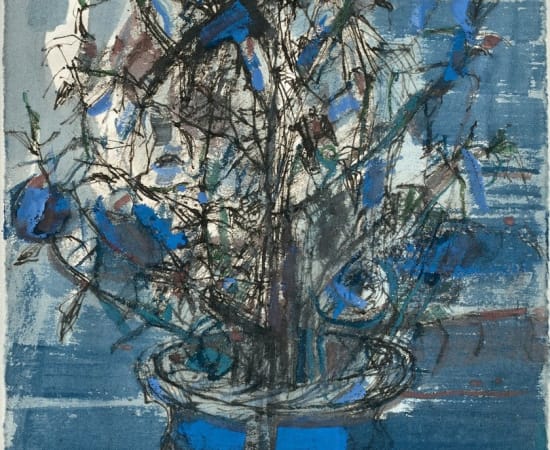Maria Helena Vieira Da Silva (1908-1992) Portuguese
Works
Biography
Maria Helena Vieira da Silva was born on June 13, 1908, in Lisbon. As a young girl she traveled widely with her affluent parents (her father was a diplomat) and encountered an array of avant-garde groups, such as the Italian Futurists and the Ballets Russes. In 1919 she entered the Academia de belas-artes, Lisbon, to study drawing with Emilia Santos Braga. She moved to Paris in 1928 to continue her formal training, enrolling in Emile-Antoine Bourdelle's sculpture course at the Académie de la grande chaumière. While in Paris, she absorbed a variety of influences from the geometric abstraction of the group Cercle et Carré ("Circle and Square", 1929-33) and Joaquín Torres-García to the decorative style of Pierre Bonnard.
Vieira da Silva's early paintings were influenced by each of these trends, and her style melds Cubism, Futurism, and Constructivism. With its keen sense of rhythm and pattern, Vieira da Silva's early work reflects a sensitivity that would become a main component in her more mature paintings, in which a sense of deep space and perspective is maintained even as jagged shapes fracture the picture plane. She had her first solo exhibition in 1933 at the Galerie Jeanne Bucher, Paris, exhibiting illustrations from a children's book along with a few paintings. At the outbreak of World War II, Vieira da Silva and her husband, painter Arpad Szenès, fled to Portugal before moving to Rio de Janeiro. Vieira da Silva continued to paint and exhibit in Brazil until she and Szenès were able to return to Paris in 1947.
In her paintings from the 1950s, Vieira da Silva focused on the postwar environment : cities that had been burned or flooded, alleyways, sunsets, and landscapes (both natural and built). Works with titles such as Canals of Holland (Canaux en Hollande, 1958), Old America (Vielle Amérique, 1958), and Collapsed Facade (Les façades éboulées, 1957) blur the specificity of place with generic prototypes : nature, culture, the city, the grid. Similar scenes are shown in endless variation, yet in each painting an underlying structure and order shines through. While primarily a painter, Vieira da Silva experimented with other mediums. In 1966 she accepted a commission to design a stained-glass window for the east chapel apse at Reims Cathedral, France. She continued to paint through the 1980s, and her later work has a notable focus on light, in both color scheme and subject matter.
Vieira da Silva's work was included in a group show at Kunsthalle Basel (1954) and at the Caracas Biennial (1958). Her first retrospective was held at the Kestner Gesellschaft, Hannover (1958), traveling to Kunsthalle Bremen, and the Kunst- und Museumsverein Wuppertal, all in West Germany. In 1958 she exhibited at the Pittsburgh International (now Carnegie International) and was mentioned in the Guggenheim International Award exhibition. Vieira da Silva had retrospectives at the Musée de Grenoble, France (1964); Museo Civico, Turin, Italy (1964); Musée national d'art moderne, Paris (1969-70); Musée Fabre, Montpellier, France (1971); Musée d'art moderne de la Ville de Paris (1977); and Fondation Juan March, Madrid (1991). She also was the honored artist at the São Paulo Biennial (1989). A French citizen since 1956, Vieira da Silva died on March 6, 1992, in Paris.
Enquire

